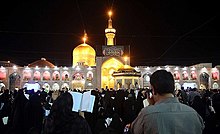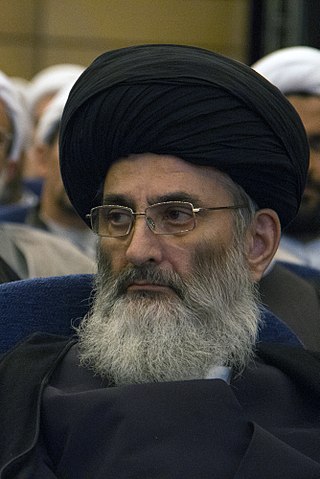Births


23 Ramadan is the twenty-third day of the ninth month (Ramadan) of the Islamic calendar.
In the Lunar Hijri calendar, this day is the 259th day of the year.


21 Ramadan is the twenty-first day of the ninth month (Ramadan) of the Islamic calendar.

Order of Culture and Art is an Iranian state general order established by "Council of Iran Ministers" on November 21, 1990 and modified on June 27, 2007. The order has three classes and awarded by President of Iran. According to Article 17 of the Regulations on the Awarding of Government Orders of Iran, the Order of Culture and Art is awarded to those who "facilitate theirs thinking, passions and emotions to express deep Islamic and humanitarian concepts and to spread culture" in one of the following ways:
Abdolmohammad Ayati was an Iranian author, translator and researcher in the field of philosophy, history and Persian and Arabic literature. He was born on 5 May 1926 in Borujerd, Borujerd County, Lorestan Province, Iran and died on 11 September 2013 in Tehran, Iran. He was selected at the second Iran's Book of the Year Awards for Arabic to Persian translation of the book History of Arabic Language Literature.
The Comprehensive History of Iran is a twenty-volume book series about various aspects of Iran's political, social and cultural history from pre-Islamic times to the extinction of the Qajar dynasty. The research, compilation and writing of this multi-volume book has lasted for 14 years. The first five volumes of this series narrate the period of ancient Iran and the other 15 volumes narrate the history of Iran in the Islamic period, political, social, cultural, scientific, literary and artistic history. One hundred and seventy foreign and domestic authors have been used to write this multi-volume book.

Seyyed Mohammad Hojjat Kooh Kamari was a contemporary Iranian Muslim Faqīh and a Twelver Marja' who was in charge of the administration of the Qom Seminary for ten years. He was born on 17 March 1893 and died on 19 January 1953. He was a prominent student of Abdul-Karim Haeri Yazdi and after him held the position of Shia authority.

The Faculty of Theology and Islamic Studies is one of the faculties of University of Tehran, which was established in 1935.

Fathollah Mojtabaei is an Iranian author and historian. He is a permanent member of Academy of Persian Language and Literature and a member of the faculty of the Center for the Great Islamic Encyclopedia.

Bibliography of Rasul Jafarian is a list of books published by Rasul Jafarian, cleric, translator, writer and researcher of Iranian history.
History of Islamic Iran is a four-volume book collection written by Rasul Jafarian in Persian language. In this collection, Jafarian writes the history of Iran from the advent of Islam to the decline of the Safavid Empire. This book has been introduced as one of the master's degree resources in the field of history and Persian literature in Iran.
Ahmad ibn Ishaq Ash'ari Qomi was one of the most trusted hadith narrators of the Shiites. He is said to have been a delegate from Qom to al-Askari. It is also said that al-Hadi paid Ahmad's debts worth thirty-thousand dinars. He met the last four Shiite Imams and was one of their companions and the agent of the 11th Shiite Imam.

This is a bibliography of the works of Morteza Motahhari.

Mahmoud Mar'ashi Najafi or Seyyed Mahmoud Mar'ashi Najafi is an Iranian librarian, Bibliographer and manuscript expert. He is the director of Mar'ashi Najafi Library, which he says is one of the largest libraries in Iran and the world.
Seyyed Qutb al-Din Mohammad Neyrizi was a prominent Iranian mystic of the Safavid period. He was 32nd Qutb of Zahabiya genealogy. All historians have written his name as Mohammad and his title as Qutb al-Din. In addition to his high position in the history of Shiite mysticism, he was one of the most important and influential political thinkers of the late Safavid period.

Zahabiya Sufism is a Shiite order. The history of dervishes from this order dates to the third century AH and Ma'ruf al-Karkhi. Some believe that the order originated during the ninth century AH in Iran; it first became popular in Khorasan and then in Shiraz during the early Safavid period.
19 Ramadan is the nineteenth day of the ninth month (Ramadan) of the Islamic calendar.

Ehya or Vigil night is one of the most important traditions among Shia Muslims. According to most commentators, vigil for the purpose of night prayer, as it appears from Surah Al-Muzzammil of the Quran was obligatory for about a year at the beginning of Islam, and Muslims performed it alongside the Islamic prophet Muhammad. According to most Islamic jurists and commentators, after about a year, according to verse 21 of the same surah, God reduced this ruling and replaced it with tahajjud. Muslims observe Ehya or Vigil night on the nineteenth, twenty-first and twenty-third nights of the Islamic month of Ramadan.
Aḥmad ibn ʿĪsā ibn Zayd Islamic theologian, Hadith scholar and Faqih, was the grandson of Zayd ibn Ali, one of the famous Alids of the early Abbasid Caliphate and one of the famous Zaydiyyah scholars who lived most of his life on the run. His kunya was Abū ʿAbd Allāh and his nickname was Al-Mukhtafī. Ahmad ibn Isa ibn Zayd 's sixty years of secret life is proof of the nickname given to him.

Mirza Jawad Agha Maleki Tabrizi or Mirza Jawad Maleki Tabrizi was a scholar of Islamic jurisprudence, principles, ethics, wisdom and Islamic mysticism.

The British occupations of Bushehr or Bushire under British occupation refers to the three times British forces entered Bushehr and occupied this area in Iran during the rule of the Qajar dynasty, before and during World War I.

Foucault in Iran: Islamic Revolution After the Enlightenment is a book by Iranian-born American historian, sociologist, and professor Behrooz Ghamari-Tabrizi as a groundbreaking reassessment of Michel Foucault's writings specially on the Iranian revolution.
به کوشش احمد صقر
{{cite book}}: CS1 maint: location missing publisher (link)۱۹۸۶ میلادی
۱۹۵۹ میلادی
مجله تاریخ اسلام ۱۳۸۴ شماره ۲۲
سال ۱۳۸۶ شماره ۲۵
سال ۱۳۸۵ شماره ۴۶ و ۴۷ ویژه نامه وحی و پیامبری